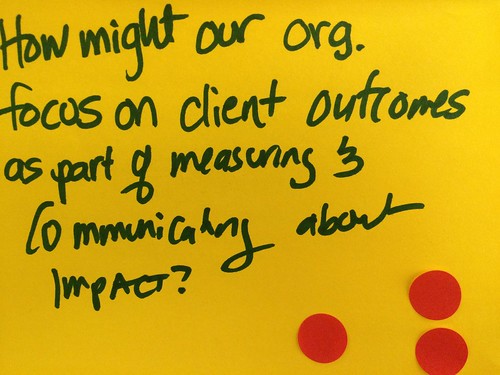
A few months ago, I facilitated a mini-innovation lab on measuring impact for grantees of the Google Nonprofit program at the Impact Hub. The workshop used design-thinking based on Luma methodology to help participants develop a communications strategy for measuring impact. The process took participants through an assessment of the problems facing them, collective brainstorming, and prototyping. The group included a mix of Google grantees as well as measurement professionals.
That’s where I met Kim Kastorff who is the founder of Kimpacto, a San Francisco-based advisory & consulting firm working across the U.S., Europe and Latin America. Her company helps mission-led businesses succeed, and also connect socially minded investors with “impact investing” opportunities, where they can generate both financial returns and social impact. She founded the firm to leverage my background in finance, education, and environmental areas. She graciously did this interview with me to share more of her knowledge.
1. Many times, nonprofits, especially smaller ones, do not have the resources to hire outside consultants to measure the impact of their programs. How can they get started?
With over 100 tools, approaches and platforms for measuring impact, the process can be overwhelming and time consuming. Here are three simple steps to get you started:
Plan for Success. Create a roadmap for measuring your financial + social impact. Acumen Fund has some free courses. Another option is to create a Theory of Change or Logic Model, which should include inputs, activities, outputs, outcomes, and impact.
Set Program Goals & Metrics. Start with the question, “what does success look like?” Clarify quantifiable outcomes or metrics that can be easily measured on a routine basis.
Report Out. If a program falls in the woods, and no one’s there to hear it… You get the picture – impact is irrelevant if no one knows about it, so be sure to share updates with both stats and stories internally (i.e. board/staff meetings) and externally (i.e. newsletters, social media, blogs, annual reports, etc.)
One last note: don’t forget to task a person or team with the ongoing responsibility for collecting, analyzing, and reporting out the intel collected. If you want to go for extra credit, you can also do sector benchmarking with resources like B Analytics and CSR HUB.
2. What goes into a good communications strategy for talking about your program’s impact?
Your communication strategy should be a combination of both financial + social impact metrics, and should consider statistics and personal stories that convey your impact. Collect this content from Day 1, and share through all your channels, as outlined above.
Effective communications strategies revolve around content tailored for your target audience, reliable data and transparency. Having a mission-aligned strategy builds trust in your organization, develops the capacity and commitment of your staff, communicates your social impact clearly to potential or existing donors, investors and board members, and promotes collaboration or opportunities for others to join in your mission.
3. What are some of the best books or blogs or other resources for learning more about measuring impact?
There are some very helpful sites and publications that look more broadly at measuring social impact. Check out these great books and resources: Measuring and Improving Social Impacts and The Impact Investor; plus the ANDE Report, the Social Impact Investment Taskforce, the Measuring Impact Guidelines, the Good Analyst, the SROI Network, the GRI guidelines, the IRIS Guide, and for a comprehensive list of tools and methods – TRASI.
4. If an organization does hire an evaluation specialist to help with measuring impact, what makes for a good relationship?
The right consultant should help you both maximize income/donations and generate even greater social impact. First, determine your budget and then select a qualified consultant. Check out B Lab’s directory and choose someone with a solid background and who understands your industry/sector, geographic focus, and target population. Be sure she/he also has experience connecting your social impact assessment to marketing and fundraising efforts, and understands the leading social impact tools and technologies. Remember – a story well told can change the world. The right consultant can help measure and communicate your data and stories, which can maximize your donations and investments. Of course, greater dollars will help expand your mission’s depth and scale. So, here’s to all of you finding your own upward spiral!
Beth Kanter is a consultant, author, influencer. virtual trainer & nonprofit innovator in digital transformation & workplace wellbeing.

Leave a Reply